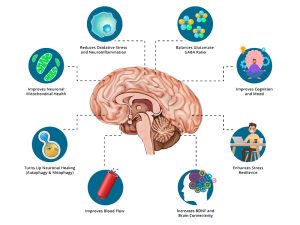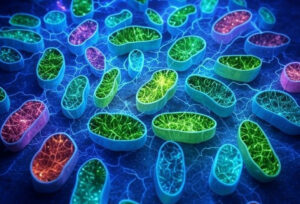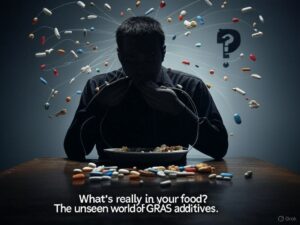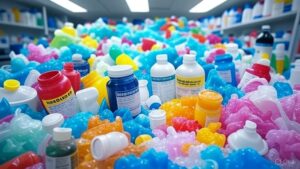Introduction: A Personal Awakening
I once believed that products approved by the U.S. Food and Drug Administration (FDA) were safe for use. But after my own battle with cancer, that illusion shattered. With the help of Grok AI and Chatbot GTP, I discovered that 7,157 unique chemicals—many of them untested or inadequately reviewed—persist in our food, drugs, packaging, and personal care products. This article is not just a critique of the FDA’s structure and oversight—it is a call for reform grounded in lived experience, regulatory history, and emerging science.
The FDA’s Flawed Governance: Overlapping Databases
The FDA’s governance is riddled with fragmentation, weak authority, and a troubling reliance on industry self-regulation. Responsibilities are split among the Center for Food Safety and Applied Nutrition (CFSAN), the Center for Drug Evaluation and Research (CDER), and a lightly managed oversight of cosmetics. The agency functions more like a passive archive for industry-submitted documents than an active safety watchdog.
The cornerstone of this problem is the ‘Generally Recognized as Safe’ (GRAS) process[1]. Originally intended to streamline approval of common food ingredients, GRAS allows substances to be deemed safe based on scientific evidence or expert consensus, often without FDA review. Today, companies can self-affirm safety by hiring their own experts, bypassing rigorous FDA oversight. Of the 3,970 substances in the FDA’s Substances Added to Food Database[2], roughly 3,670 have never undergone active FDA safety assessments.
Industry influence compounds the problem. From 1998 to 2025, the ultraprocessed food industry spent $1.4 billion lobbying, while pharmaceutical firms spent $6.3 billion. These efforts have blocked reform—most notably the closure of the GRAS self-affirmation loophole[3], which remains open despite HHS Secretary Robert F. Kennedy Jr.’s March 2025 directive to eliminate it[1].
Historical Context and Regulatory Evolution
When the FDA was created in 1906 under the Pure Food and Drugs Act, the food supply contained few synthetic chemicals. The agency’s early mission focused on preventing adulteration and mislabeling. With the 1938 Federal Food, Drug, and Cosmetic Act, the FDA was empowered to conduct drug safety reviews. The 1958 Food Additives Amendment created the GRAS exemption[3], initially listing about 700 substances.
Over the decades, the GRAS process grew to include thousands of additional substances through self-affirmation. In 1997, a voluntary notification system further weakened FDA’s oversight. Parallel gaps in cosmetics, OTC drugs, and supplements evolved similarly. The result: 7,157 unique chemicals now permeate the U.S. consumer landscape, many without adequate federal oversight.
The Scale of Chemical Exposure
The FDA maintains several overlapping databases, each detailing different chemical categories:
- Substances Added to Food (3,970 substances): Includes sodium benzoate, which can form carcinogenic benzene when combined with ascorbic acid[4], and monocalcium phosphate, a leavening agent linked to health risks from high phosphorus intake[5].
- Inventory of Food Contact Substances (3,652 substances)[7].
- Select Committee on GRAS Substances (SCOGS): 451 entries (370 substances), including carrageenan, linked to inflammation and cancer risks[8].
- Inactive Ingredients Database (9,196 entries, 1,048 unique substances): Includes propylparaben, an endocrine disruptor[9].
- Dietary Supplement Label Database (205,782 labels): Includes ascorbic acid, which poses risks of overexposure in self-affirmed uses[10].
These databases often rely on industry data, not independent review, leaving Americans exposed to substances never meaningfully tested for long-term safety.
The Hidden Health Risks
Of the 7,157 unique chemicals in circulation, many are endocrine disruptors—compounds that interfere with hormonal systems[11]. These are linked to obesity, infertility, diabetes, and even cancer. Research suggests up to 20% of food additives may have endocrine-disrupting properties[12].
Notable examples:
- Propylparaben in drugs and lotions mimics estrogen and may impair reproductive health[13].
- Carrageenan used in food and toothpaste contributes to colitis and chronic inflammation[14].
- Sodium benzoate, still legal, may generate carcinogenic byproducts when paired with vitamin C[6].
Consumers often assume FDA approval means safety, but unless they dig into obscure databases or advocacy sites, they’re unaware of these systemic risks.
Overlapping Oversight and Personal Care Risks
Personal care products pose unique risks. Ingredients like propylparaben, commonly found in creams and lotions, are absorbed through the skin. Despite their systemic impact, cosmetics remain under-regulated. No dedicated FDA database exists to track their safety, perpetuating exposure through regulatory neglect.
Seeking Transparency
For proactive consumers, tools exist but require effort. The Inactive Ingredients Database (IID)[9] and apps like Yuka[15] allow users to check ingredient profiles, but they lack plain-language risk summaries. Meaningful transparency will require integrating FDA databases into a single, user-friendly platform.
A Call for Comprehensive Reform
To protect public health, the FDA must:
- Consolidate CFSAN, CDER, and cosmetic oversight into one cohesive regulatory body.
- Eliminate GRAS self-affirmation and require FDA review of all safety claims.
- Limit industry lobbying and funding of research tied to regulatory decisions.
- Create a single, public database of all approved chemicals with searchable summaries.
- Despite evidence of harm, unsafe substances often remain in use for years due to slow regulatory action, perpetuating public health risks.
- Immediately restrict high-risk substances like Red No. 40[16], and propylparaben instead of phasing them out over the years.
Until reform arrives, Americans must become their own watchdogs—researching the safety of food, medication, personal care products, and even their tap water.
Footnotes
[1] GRAS Self-Affirmation Directive: HHS Announcement on GRAS Reform – On March 10, 2025, HHS Secretary Robert F. Kennedy Jr. directed the FDA to explore rulemaking to eliminate the GRAS self-affirmation pathway; check the FDA’s website for updates on rulemaking status as of June 5, 2025. https://www.hhs.gov/press-room/revising-gras-pathway.html ↑ ↑
[2] Substances Added to Food Database: Substances Added to Food Database | FDA – Managed by the FDA’s Center for Food Safety and Applied Nutrition and made publicly available online around 2001 under regulations like 21 CFR Parts 172 and 182 stemming from the 1958 Food Additives Amendment, this database includes 3,970 substances used in food, encompassing GRAS substances (both codified and self-affirmed), direct additives, and more, far exceeding the codified GRAS list of ~300 substances. https://www.hfpappexternal.fda.gov/scripts/fdcc/index.cfm?set=FoodSubstances ↑
[3] GRAS Self-Affirmation Loophole: What is GRAS? – Environmental Working Group – The GRAS designation allows companies to self-affirm food substances as safe without mandatory FDA review, creating a loophole that leaves thousands of substances, including many in the Substances Added to Food Database, without rigorous oversight, raising significant safety and transparency concerns. https://www.ewg.org/news-insights/news/2025/03/what-gras ↑ ↑
[4] Sodium Benzoate: Sodium Benzoate – National Library of Medicine; Toxicological and Teratogenic Effect of Various Food Additives: An Updated Review – A preservative linked to hyperactivity in children when combined with artificial colors and potential carcinogenic byproducts like benzene when mixed with ascorbic acid (EFSA, 2007; IARC, 2018); recent research also highlights risks of developmental harm and broader toxicological concerns (Bhateria et al., 2024). https://pubchem.ncbi.nlm.nih.gov/compound/Sodium-benzoate ↑
[5] Monocalcium Phosphate: Monocalcium Phosphate – National Library of Medicine; Dietary Phosphorus Intake and Mortality in NHANES III: A Parabolic Association – A leavening agent in baking powder; high phosphorus intake from such additives has been linked to increased all-cause mortality, particularly due to cardiovascular and renal complications (Chang et al., 2014). https://pmc.ncbi.nlm.nih.gov/articles/PMC3893724/ ↑
[6] Ascorbic Acid (Vitamin C): Vitamin C – Health Professional Fact Sheet | NIH Office of Dietary Supplements – A nutrient and preservative, but high doses may cause gastrointestinal issues; self-affirmed GRAS uses may lead to overexposure risks. https://ods.od.nih.gov/factsheets/VitaminC-HealthProfessional/ ↑
[7] Inventory of Food Contact Substances Listed in 21 CFR (Indirect Additives Database): Inventory of Effective Food Contact Substances Listed in 21 CFR – This inventory catalogs food contact substances under 21 CFR Parts 174–178, providing notifications for substances used in food packaging. https://www.fda.gov/food/packaging-food-contact-substances-fcs/inventory-effective-food-contact-substance-fcs-notifications ↑
[8] Select Committee on GRAS Substances Database (SCOGS): SCOGS (Select Committee on GRAS Substances) Database | FDA – Contains reports from 1972 to 1980 reviewing GRAS substances’ safety, established under 21 CFR 170.35. https://www.hfpappexternal.fda.gov/scripts/fdcc/index.cfm?set=SCOGS ↑
[9] Inactive Ingredients Database for FDA-Approved Drugs (IID): Inactive Ingredients Database | FDA – Lists inactive ingredients in FDA-approved drugs, including maximum potency levels, managed by the Center for Drug Evaluation and Research (CDER). https://www.fda.gov/drugs/drug-approvals-and-databases/inactive-ingredients-database-download ↑ ↑
[10] Dietary Supplement Label Database (DSLD): Dietary Supplement Label Database | NIH – Managed by the NIH’s Office of Dietary Supplements with updates integrated by the FDA as of May 23, 2025, this database provides label information and safety communications for dietary supplement ingredients, including vitamins. https://dsld.od.nih.gov/ ↑
[11] Endocrine Disruptors Video: Endocrine Disrupting Chemicals: What are EDCs and Why Should You Care? – YouTube – The Endocrine Society explains how EDCs mimic or block hormones, disrupting critical processes like reproduction and metabolism (Endocrine Society, 2017). https://www.youtube.com/watch?v=ibfAF66JzFE ↑
[12] Endocrine Disruptors Statistic: Endocrine-Disrupting Chemicals: An Endocrine Society Scientific Statement – The Endocrine Society has reported, based on studies and advocacy materials around 2019, that up to 20% of food additives may have endocrine-disrupting properties, primarily applies to direct food additives (Gore et al., 2015). https://academic.oup.com/edrv/article/36/6/E1/2354691 ↑
[13] Propylparaben: Propylparaben Induces Reproductive Toxicity in Human Extravillous Trophoblast Cells via Apoptosis and Cell Cycle Pathways – A preservative that may mimic estrogen and contribute to reproductive toxicity and developmental risks in human trophoblast cells (Yang et al., 2024). https://pubs.acs.org/doi/10.1021/envhealth.3c00083 ↑
[14] Carrageenan: The Role of Carrageenan in Inflammatory Bowel Diseases and Allergic Reactions: Where Do We Stand? – An emulsifier in food and cosmetics, which may contribute to inflammatory bowel diseases like colitis and allergic reactions, potentially increasing cancer risk through chronic inflammation (Di Tommaso et al., 2021). https://pmc.ncbi.nlm.nih.gov/articles/PMC8539934/ ↑
[15] Yuka App: Yuka – A mobile application that scans product barcodes to assess the safety and nutritional quality of food, cosmetics, and other consumer goods based on scientific data, offering an alternative to FDA-provided information. https://yuka.io/en/ ↑
[16] Red No. 40: Behavioral toxicology of food additives: An updated review – An artificial color linked to hyperactivity in children since the 1980s, banned in food by 2028 but historically used in both food and drugs (Weiss et al., 1983). https://www.sciencedirect.com/science/article/abs/pii/0300483X8390118X ↑
Learn more about the resources to get more ideas.

Linda Wulf
My journey with CNS lymphoma not only shaped my perspective on health but ignited a mission to uncover and educate about the myriad chemicals we encounter every day.










